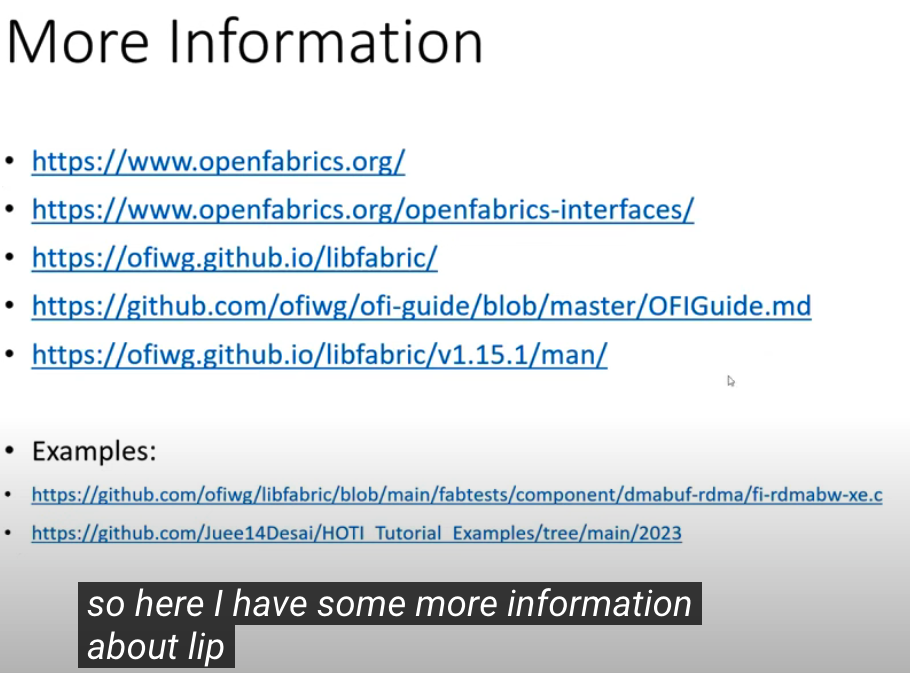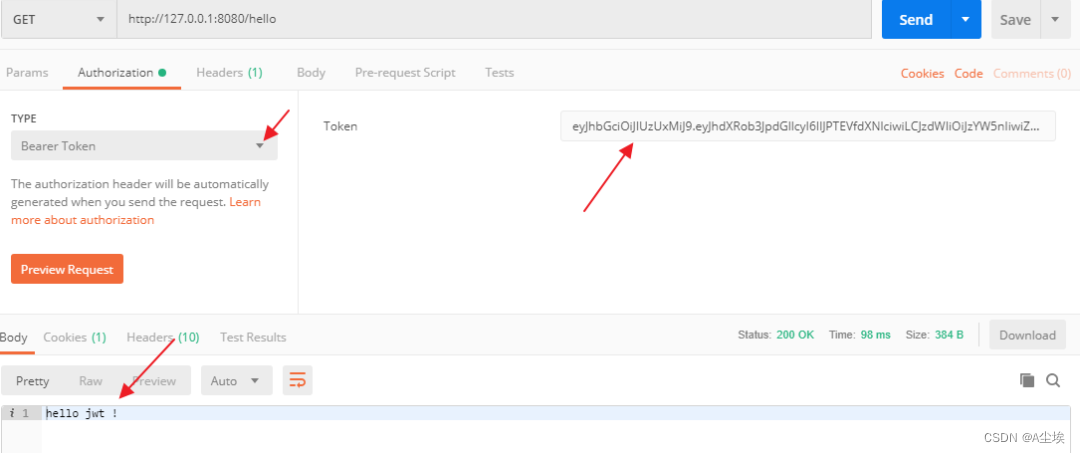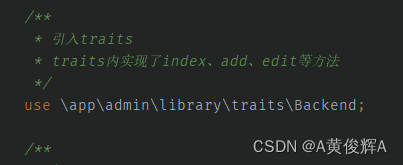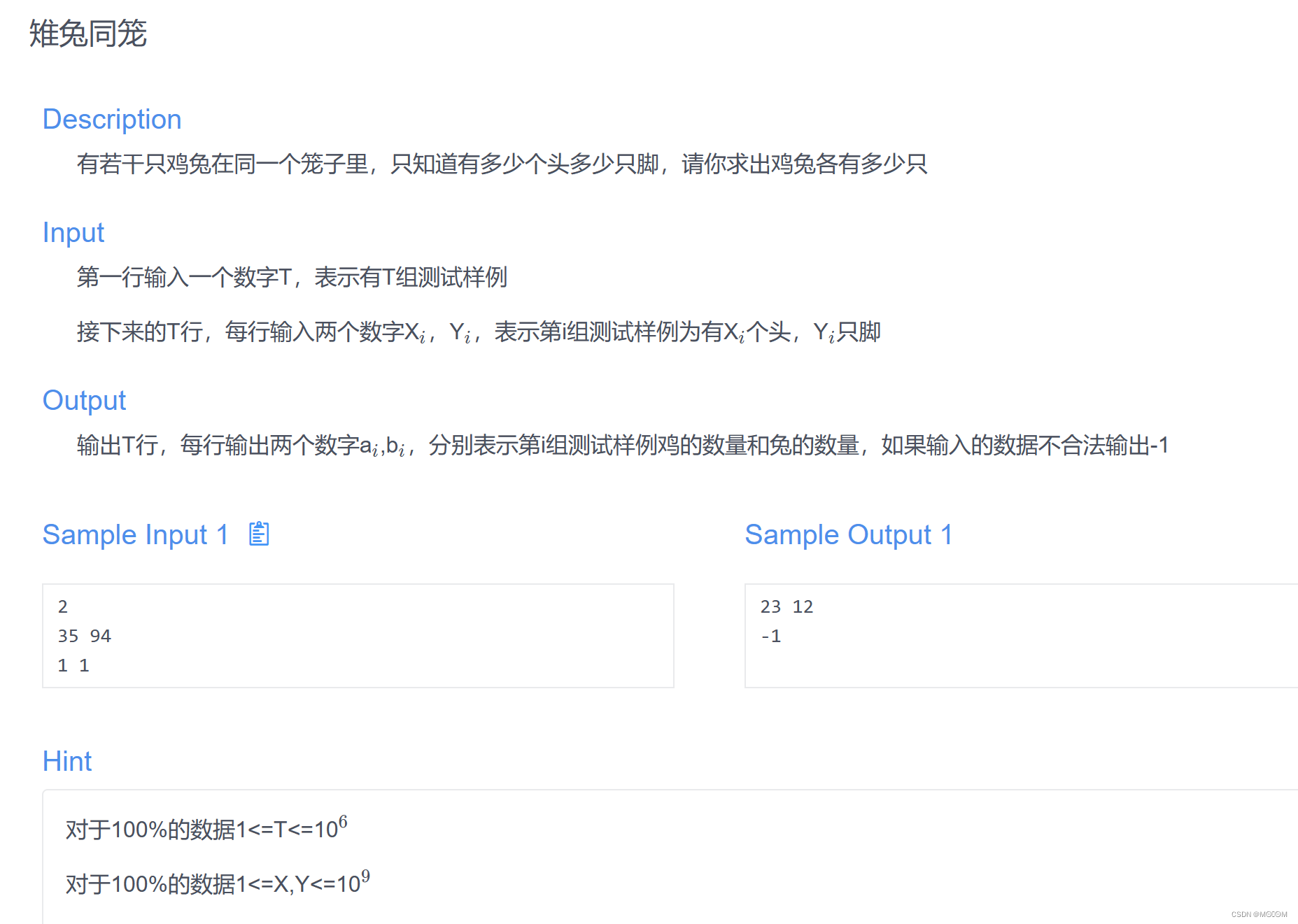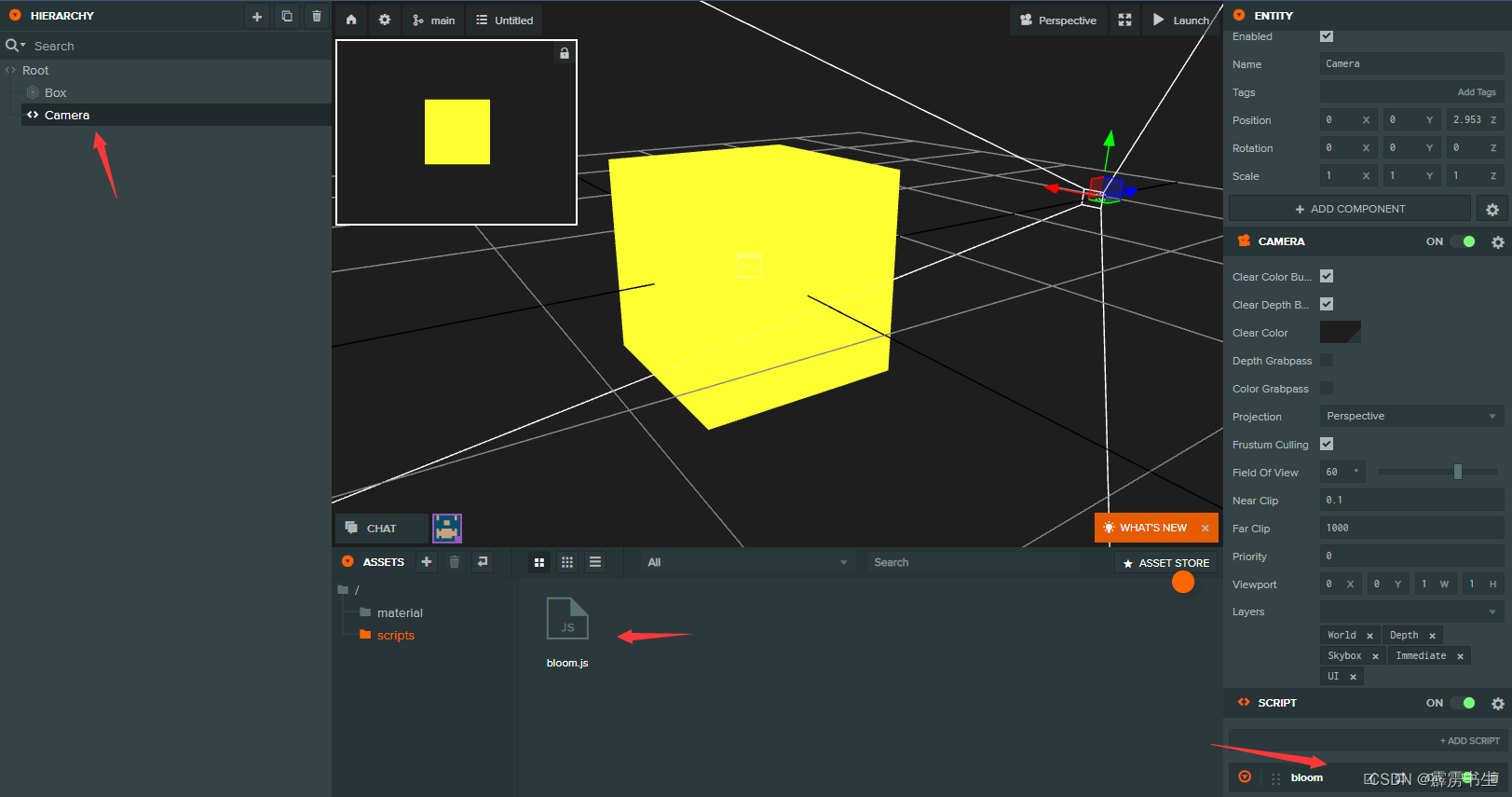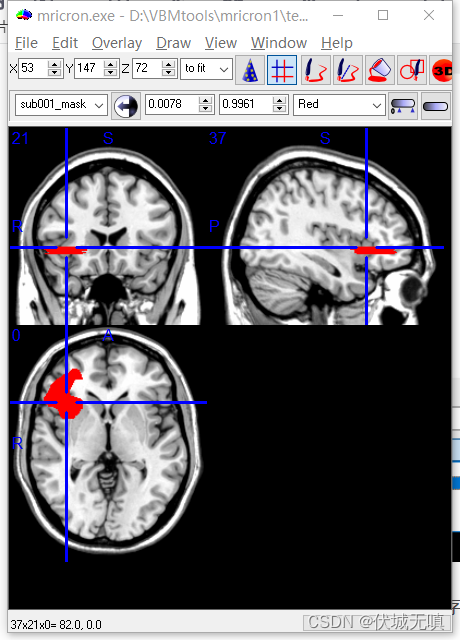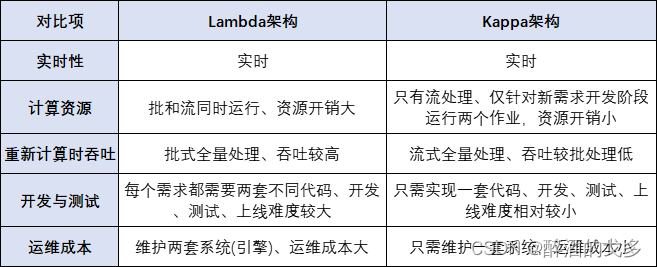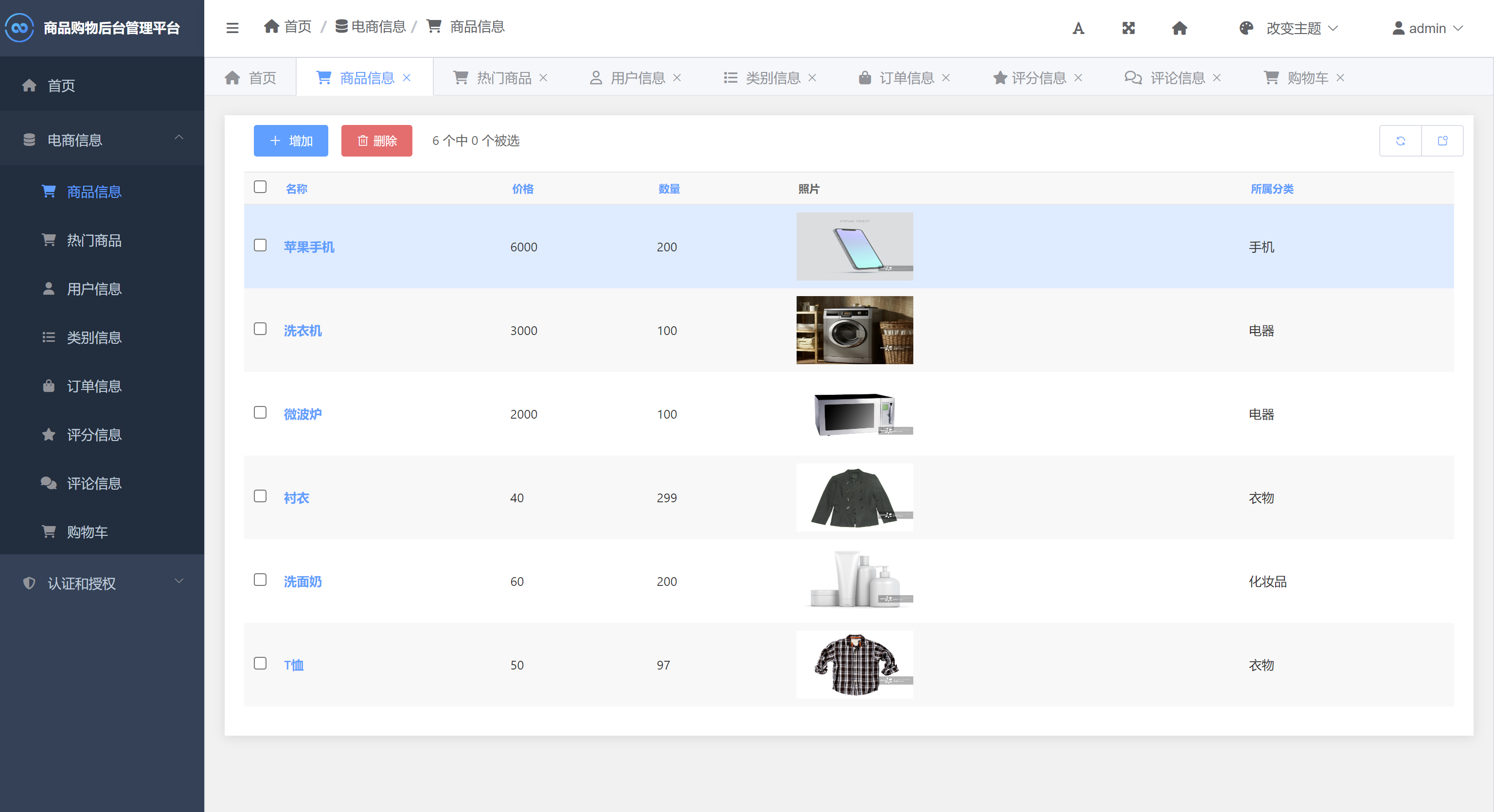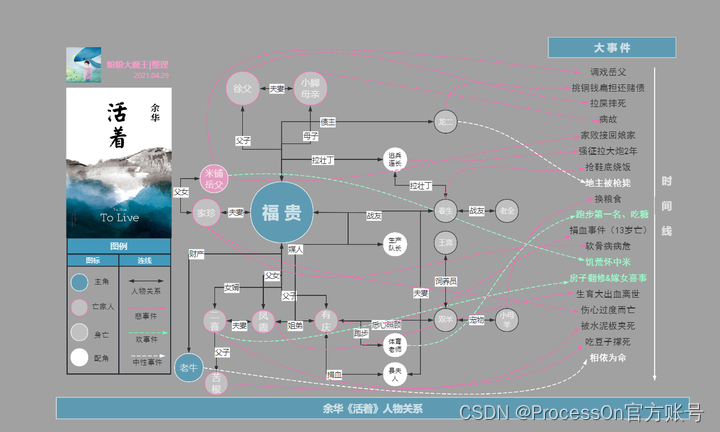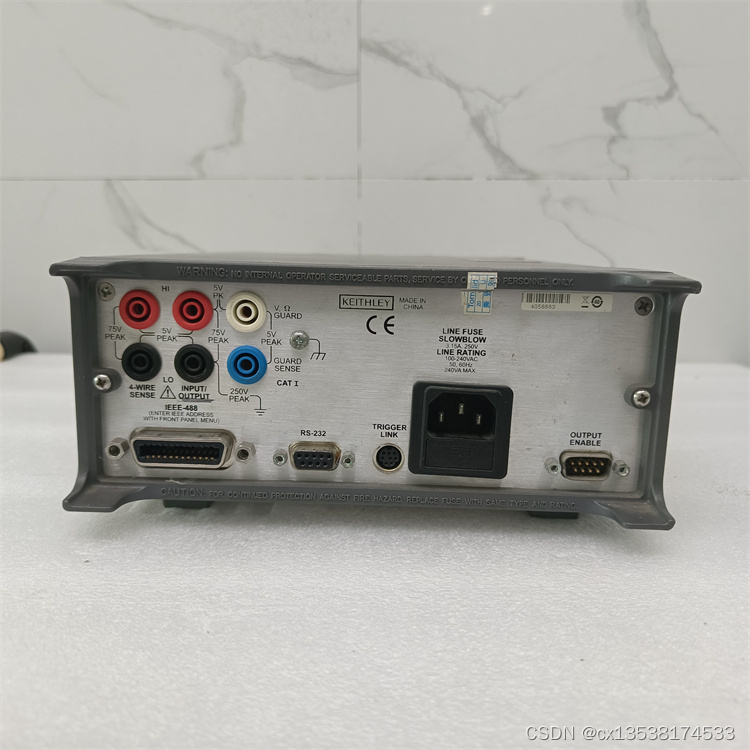
Agenda 目录/议题
- 编译通信软件
- 硬件和软件带来的挑战
- 为什么需要libfabric
- libfabric架构
- API分组
- socket应用 VS libfabric应用区别
- GPU数据传输示例

编译通信软件

- 可靠面向连接的TCP和无连接的数据报UDP协议
- 高性能计算HPC或人工智能AI

软硬件复杂性带来的挑战

- 上千个节点的集群, 不同的网络类型(以太网, IB, 光纤等), 熊猫博士提到的CPU/GPU/XPU/IPU等等
- xelink, nvlink, gpu
- 软件库, 如nccl,intel mpi等
- 所以咱们需要一个通用的通信库来桥接这些复杂的软硬件资源
libfabric来解决上面的问题

- 统一API, 让程序员更轻松
- 高性能和高可扩展性
- 核心组件: 众多网卡提供者的库, 核心服务, 测试程序等
为什么需要libfabric

- 承上启下, 桥接底层复杂多样的网络(socket, rdma, gpu, 共享内存等)和上层MPI, CCL, 共享内存等应用
socket编程与libfabric编程对比

- 语义类似, 如获取信息, bind, connect等, 但是libfabric底层支持多种网络类型
支持GPU通信

- gpu通信示例, 支持intel gpu, dpu, 或者其他供应商
架构与四种服务

- 控制类: 发现底层设备, 属性, 能力等
- 通信接口: 建立连接, 初始资源等
- 数据传输: 发送和接收数据
- 完成服务: 报告发送或接收状态
libfabric API分组

- 整合底层提供者和上层开发者使用统一的API编程, 就像熊猫博士说的那样, 方便了提供者更方便的提供插件, 也方便了上层应用开发者
tcp socket 代码截图

socket收发数据示例

server端启动:./example_socket客户端连接和发送:./example_socket 192.168.5.6Hello server this is client.example_socket.c 源码
#include <stdio.h>
#include <string.h>
#include <sys/socket.h>
#include <arpa/inet.h>
char *dst_addr = NULL;
int main(int argc, char *argv[])
{
int socket_desc, client_sock, client_size;
struct sockaddr_in server_addr, client_addr;
char server_message[2000], client_message[2000];
dst_addr = inet_addr(argv[1]);
// Clean buffers:
memset(server_message, '\0', sizeof(server_message));
memset(client_message, '\0', sizeof(client_message));
// Create socket:
socket_desc = socket(AF_INET, SOCK_STREAM, 0);
if(socket_desc < 0){
printf("Error while creating socket\n");
return -1;
}
printf("Socket created successfully\n");
// Set port and IP:
server_addr.sin_family = AF_INET;
server_addr.sin_port = "43192";
server_addr.sin_addr.s_addr = inet_addr("127.0.0.1");
if (!dst_addr) {
// Bind to the set port and IP:
if(bind(socket_desc, (struct sockaddr*)&server_addr, sizeof(server_addr))<0){
printf("Couldn't bind to the port\n");
return -1;
}
printf("Binding complete\n");
// Listen for clients:
if(listen(socket_desc, 1) < 0){
printf("Error while listening\n");
return -1;
}
printf("Listening for incoming connections...\n");
// Accept an incoming connection:
client_size = sizeof(client_addr);
client_sock = accept(socket_desc, (struct sockaddr*)&client_addr, &client_size);
if (client_sock < 0){
printf("Can't accept\n");
return -1;
}
printf("Client connected at IP: %s and port: %i\n", inet_ntoa(client_addr.sin_addr), ntohs(client_addr.sin_port));
// Receive client's message:
if (recv(client_sock, client_message, sizeof(client_message), 0) < 0){
printf("Couldn't receive\n");
return -1;
}
printf("Msg from client: %s\n", client_message);
// Respond to client:
strcpy(server_message, "This is the server's message.");
if (send(client_sock, server_message, strlen(server_message), 0) < 0){
printf("Can't send\n");
return -1;
}
}
if (dst_addr) {
// Send connection request to server:
if(connect(socket_desc, (struct sockaddr*)&server_addr, sizeof(server_addr)) < 0){
printf("Unable to connect\n");
return -1;
}
printf("Connected with server successfully\n");
// Get input from the user:
printf("Enter message: ");
gets(client_message);
// Send the message to server:
if(send(socket_desc, client_message, strlen(client_message), 0) < 0){
printf("Unable to send message\n");
return -1;
}
// Receive the server's response:
if(recv(socket_desc, server_message, sizeof(server_message), 0) < 0){
printf("Error while receiving server's msg\n");
return -1;
}
printf("Server's response: %s\n",server_message);
}
// Close the client socket:
close(client_sock);
// Closing the server socket:
close(socket_desc);
return 0;
}libfabric收发数据示例截图

服务端启动: ./example_msg客户端连接发送数据: ./example_msg 192.168.5.6
客户端连接发送数据: ./example_msg 192.168.5.6参考代码
https://github.com/ssbandjl/libfabric/blob/main/fabtests/functional/example_msg.c
/*
*
* This software is available to you under the BSD license
* below:
*
* Redistribution and use in source and binary forms, with or
* without modification, are permitted provided that the following
* conditions are met:
*
* - Redistributions of source code must retain the above
* copyright notice, this list of conditions and the following
* disclaimer.
*
* - Redistributions in binary form must reproduce the above
* copyright notice, this list of conditions and the following
* disclaimer in the documentation and/or other materials
* provided with the distribution.
*
* THE SOFTWARE IS PROVIDED "AS IS", WITHOUT WARRANTY OF ANY KIND,
* EXPRESS OR IMPLIED, INCLUDING BUT NOT LIMITED TO THE WARRANTIES OF
* MERCHANTABILITY, FITNESS FOR A PARTICULAR PURPOSE AND
* NONINFRINGEMENT. IN NO EVENT SHALL THE AUTHORS OR COPYRIGHT HOLDERS
* BE LIABLE FOR ANY CLAIM, DAMAGES OR OTHER LIABILITY, WHETHER IN AN
* ACTION OF CONTRACT, TORT OR OTHERWISE, ARISING FROM, OUT OF OR IN
* CONNECTION WITH THE SOFTWARE OR THE USE OR OTHER DEALINGS IN THE
* SOFTWARE.
*/
#include <stdio.h>
#include <stdlib.h>
#include <getopt.h>
#include <netinet/in.h>
#include <arpa/inet.h>
#include <netdb.h>
#include <rdma/fabric.h>
#include <rdma/fi_domain.h>
#include <rdma/fi_endpoint.h>
#include <rdma/fi_cm.h>
#include <shared.h>
//Build with
//gcc -o example_msg example_msg.c -L<path to libfabric lib> -I<path to libfabric include> -lfabric
//gcc -o example_msg example_msg.c -L/home/xb/project/libfabric/libfabric/build/lib -I/home/xb/project/libfabric/libfabric/build/include -I/home/xb/project/libfabric/libfabric/build/include -lfabric
#define BUF_SIZE 64
char *dst_addr = NULL;
char *port = "9228";
struct fi_info *hints, *info, *fi_pep;
struct fid_fabric *fabric = NULL;
struct fid_domain *domain = NULL;
struct fid_ep *ep = NULL;
struct fid_pep *pep = NULL;
struct fid_cq *cq = NULL;
struct fid_eq *eq = NULL;
struct fi_cq_attr cq_attr = {0};
struct fi_eq_attr eq_attr = {
.wait_obj = FI_WAIT_UNSPEC
};
//const struct sockaddr_in *sin;
char str_addr[INET_ADDRSTRLEN];
int ret;
char buffer[BUF_SIZE];
fi_addr_t fi_addr = FI_ADDR_UNSPEC;
struct fi_eq_cm_entry entry;
uint32_t event;
ssize_t rd;
/* Initializes all basic OFI resources to allow for a server/client to exchange a message */
static int start_client(void)
{
ret = fi_getinfo(FI_VERSION(1,9), dst_addr, port, dst_addr ? 0 : FI_SOURCE,
hints, &info);
if (ret) {
printf("fi_getinfo: %d\n", ret);
return ret;
}
ret = fi_fabric(info->fabric_attr, &fabric, NULL);
if (ret) {
printf("fi_fabric: %d\n", ret);
return ret;
}
ret = fi_eq_open(fabric, &eq_attr, &eq, NULL);
if (ret) {
printf("fi_eq_open: %d\n", ret);
return ret;
}
ret = fi_domain(fabric, info, &domain, NULL);
if (ret) {
printf("fi_domain: %d\n", ret);
return ret;
}
/* Initialize our completion queue. Completion queues are used to report events associated
* with data transfers. In this example, we use one CQ that tracks sends and receives, but
* often times there will be separate CQs for sends and receives.
*/
cq_attr.size = 128;
cq_attr.format = FI_CQ_FORMAT_MSG;
ret = fi_cq_open(domain, &cq_attr, &cq, NULL);
if (ret) {
printf("fi_cq_open error (%d)\n", ret);
return ret;
}
/* Bind our CQ to our endpoint to track any sends and receives that come in or out on that endpoint.
* A CQ can be bound to multiple endpoints but one EP can only have one send CQ and one receive CQ
* (which can be the same CQ).
*/
ret = fi_endpoint(domain, info, &ep, NULL);
if (ret) {
printf("fi_endpoint: %d\n", ret);
return ret;
}
ret = fi_ep_bind(ep, &cq->fid, FI_SEND | FI_RECV);
if (ret) {
printf("fi_ep_bind cq error (%d)\n", ret);
return ret;
}
ret = fi_ep_bind((ep), &(eq)->fid, 0);
if (ret) {
printf("fi_ep_bind: %d\n", ret);
return ret;
}
ret = fi_enable(ep);
if (ret) {
printf("fi_enable: %d\n", ret);
return ret;
}
ret = fi_connect(ep, info->dest_addr, NULL, 0);
if (ret) {
printf("fi_connect: %d\n", ret);
return ret;
}
rd = fi_eq_sread(eq, &event, &entry, sizeof(entry), -1, 0);
if (rd != sizeof(entry)) {
ret = (int) rd;
printf("fi_eq_sread: %d\n", ret);
return ret;
}
return 0;
}
static int start_server(void)
{
const struct sockaddr_in *sin;
/* The first OFI call to happen for initialization is fi_getinfo which queries libfabric
* and returns any appropriate providers that fulfill the hints requirements. Any applicable
* providers will be returned as a list of fi_info structs (&info). Any info can be selected.
* In this test we select the first fi_info struct. Assuming all hints were set appropriately,
* the first fi_info should be most appropriate.
* The flag FI_SOURCE is set for the server to indicate that the address/port refer to source
* information. This is not set for the client because the fields refer to the server, not
* the caller (client). */
/* 初始化时发生的第一个 OFI 调用是 fi_getinfo,它查询 libfabric 并返回满足提示要求的任何适当的提供程序。 任何适用的提供程序都将作为 fi_info 结构 (&info) 列表返回。 可以选择任何信息。 在此测试中,我们选择第一个 fi_info 结构。 假设所有提示均已正确设置,第一个 fi_info 应该是最合适的。 为服务器设置标志FI_SOURCE以指示地址/端口引用源信息。 这不是为客户端设置的,因为这些字段引用服务器,而不是调用者(客户端) */
ret = fi_getinfo(FI_VERSION(1,9), dst_addr, port, dst_addr ? 0 : FI_SOURCE,
hints, &fi_pep);
if (ret) {
printf("fi_getinfo error (%d)\n", ret);
return ret;
}
/* Initialize our fabric. The fabric network represents a collection of hardware and software
* resources that access a single physical or virtual network. All network ports on a system
* that can communicate with each other through their attached networks belong to the same fabric.
*/
ret = fi_fabric(fi_pep->fabric_attr, &fabric, NULL); // 打开fabric, 初始化任何资源前需要打开fabric
if (ret) {
printf("fi_fabric error (%d)\n", ret);
return ret;
}
/* Initialize our endpoint. Endpoints are transport level communication portals which are used to
* initiate and drive communication. There are three main types of endpoints:
* FI_EP_MSG - connected, reliable
* FI_EP_RDM - unconnected, reliable
* FI_EP_DGRAM - unconnected, unreliable
* The type of endpoint will be requested in hints/fi_getinfo. Different providers support different
* types of endpoints. TCP supports only FI_EP_MSG but when used with RxM, can support FI_EP_RDM.
* In this application, we requested TCP and FI_EP_MSG.
*/
ret = fi_eq_open(fabric, &eq_attr, &eq, NULL); // 打开事件队列EQ, 一般用于建连, 收发数据产生的事件
if (ret) {
printf("fi_eq_open: %d\n", ret);
return ret;
}
ret = fi_passive_ep(fabric, fi_pep, &pep, NULL); // 打开被动端点, 常用与服务端监听端口, 支持多个客户端domain连接进来
if (ret) {
printf("fi_passive_ep: %d\n", ret);
return ret;
}
ret = fi_pep_bind(pep, &eq->fid, 0); // 为端点绑定事件队列
if (ret) {
printf("fi_pep_bind %d", ret);
return ret;
}
ret = fi_listen(pep); // 监听端点, 等待客户端连接请求
if (ret) {
printf("fi_listen %d", ret);
return ret;
}
return 0;
}
static int complete_connection(void)
{
rd = fi_eq_sread(eq, &event, &entry, sizeof(entry), -1, 0); // 等待读取客户端触发的服务端事件, 读取事件, 推动进展(驱动程序运转)
if (rd != sizeof entry) {
ret = (int) rd;
printf("fi_eq_sread: %d", ret);
if (ret)
goto err;
}
ret = fi_domain(fabric, info, &domain, NULL); // domain域用于将资源分组, 可基于域来做管理
if (ret) {
printf("fi_domain: %d\n", ret);
return ret;
}
ret = fi_domain_bind(domain, &eq->fid, 0);
if (ret) {
printf("fi_domain_bind: %d\n", ret);
return ret;
}
/*
* Initialize our completion queue. Completion queues are used to report events associated
* with data transfers. In this example, we use one CQ that tracks sends and receives, but
* often times there will be separate CQs for sends and receives.
*/
cq_attr.size = 128;
cq_attr.format = FI_CQ_FORMAT_MSG;
ret = fi_cq_open(domain, &cq_attr, &cq, NULL);
if (ret) {
printf("fi_cq_open error (%d)\n", ret);
return ret;
}
/* Bind our CQ to our endpoint to track any sends and receives that
* come in or out on that endpoint. A CQ can be bound to multiple
* endpoints but one EP can only have one send CQ and one receive CQ
* (which can be the same CQ).
*/
ret = fi_endpoint(domain, info, &ep, NULL); // 用于客户端, 主动端点, 发起建连
if (ret) {
printf("fi_endpoint: %d\n", ret);
return ret;
}
ret = fi_ep_bind(ep, &cq->fid, FI_SEND | FI_RECV);
if (ret) {
printf("fi_ep_bind cq error (%d)\n", ret);
return ret;
}
ret = fi_ep_bind((ep), &(eq)->fid, 0);
if (ret) {
printf("fi_ep_bind: %d\n", ret);
return ret;
}
ret = fi_enable(ep);
if (ret) {
printf("fi_enable: %d", ret);
return ret;
}
ret = fi_accept(ep, NULL, 0);
if (ret) {
printf("fi_accept: %d\n", ret);
return ret;
}
rd = fi_eq_sread(eq, &event, &entry, sizeof(entry), -1, 0);
if (rd != sizeof(entry)) {
ret = (int) rd;
printf("fi_eq_read: %d\n", ret);
return ret;
}
return 0;
err:
if (info)
fi_reject(pep, info->handle, NULL, 0);
return ret;
}
static void cleanup(void)
{
int ret;
/* All OFI resources are cleaned up using the same fi_close(fid) call. */
if (ep) {
ret = fi_close(&ep->fid);
if (ret)
printf("warning: error closing EP (%d)\n", ret);
}
if (pep) {
ret = fi_close(&pep->fid);
if (ret)
printf("warning: error closing PEP (%d)\n", ret);
}
ret = fi_close(&cq->fid);
if (ret)
printf("warning: error closing CQ (%d)\n", ret);
ret = fi_close(&domain->fid);
if (ret)
printf("warning: error closing domain (%d)\n", ret);
ret = fi_close(&eq->fid);
if (ret)
printf("warning: error closing EQ (%d)\n", ret);
ret = fi_close(&fabric->fid);
if (ret)
printf("warning: error closing fabric (%d)\n", ret);
if (info)
fi_freeinfo(info);
if (fi_pep)
fi_freeinfo(fi_pep);
}
/* Post a receive buffer. This call does not ensure a message has been received, just
* that a buffer has been passed to OFI for the next message the provider receives.
* Receives may be directed or undirected using the address parameter. Here, we
* pass in the fi_addr but note that the server has not inserted the client's
* address into its AV, so the address is still FI_ADDR_UNSPEC, indicating that
* this buffer may receive incoming data from any address. An application may
* set this to a real fi_addr if the buffer should only receive data from a certain
* peer.
* When posting a buffer, if the provider is not ready to process messages (because
* of connection initialization for example), it may return -FI_EAGAIN. This does
* not indicate an error, but rather that the application should try again later.
* This is why we almost always wrap sends and receives in a do/while. Some providers
* may need the application to drive progress in order to get out of the -FI_EAGAIN
* loop. To drive progress, the application needs to call fi_cq_read (not necessarily
* reading any completion entries).
*/
static int post_recv(void)
{
int ret;
do {
ret = fi_recv(ep, buffer, BUF_SIZE, NULL, fi_addr, NULL);
if (ret && ret != -FI_EAGAIN) {
printf("error posting recv buffer (%d\n", ret);
return ret;
}
if (ret == -FI_EAGAIN)
(void) fi_cq_read(cq, NULL, 0);
} while (ret);
return 0;
}
/* Post a send buffer. This call does not ensure a message has been sent, just that
* a buffer has been submitted to OFI to be sent. Unlike a receive buffer, a send
* needs a valid fi_addr as input to tell the provider where to send the message.
* Similar to the receive buffer posting porcess, when posting a send buffer, if the
* provider is not ready to process messages, it may return -FI_EAGAIN. This does not
* indicate an error, but rather that the application should try again later. Just like
* the receive, we drive progress with fi_cq_read if this is the case.
*/
static int post_send(void)
{
char *msg = "Hello, server! I am the client you've been waiting for!\0";
int ret;
(void) snprintf(buffer, BUF_SIZE, "%s", msg);
do {
ret = fi_send(ep, buffer, BUF_SIZE, NULL, fi_addr, NULL);
if (ret && ret != -FI_EAGAIN) {
printf("error posting send buffer (%d)\n", ret);
return ret;
}
if (ret == -FI_EAGAIN)
(void) fi_cq_read(cq, NULL, 0);
} while (ret);
return 0;
}
/* Wait for the message to be sent/received using the CQ. fi_cq_read not only drives progress
* but also returns any completed events to notify the application that it can reuse
* the send/recv buffer. The returned completion entry will have fields set to let the application
* know what operation completed. Not all fields will be valid. The fields set will be indicated
* by the cq format (when creating the CQ). In this example, we use FI_CQ_FORMAT_MSG in order to
* use the flags field.
*/
static int wait_cq(void)
{
struct fi_cq_err_entry comp;
int ret;
do {
ret = fi_cq_read(cq, &comp, 1);
if (ret < 0 && ret != -FI_EAGAIN) {
printf("error reading cq (%d)\n", ret);
return ret;
}
} while (ret != 1);
if (comp.flags & FI_RECV)
printf("I received a message!\n");
else if (comp.flags & FI_SEND)
printf("My message got sent!\n");
return 0;
}
static int run(void)
{
int ret;
if (dst_addr) {
printf("Client: send to server %s\n", dst_addr);
ret = post_send();
if (ret)
return ret;
ret = wait_cq();
if (ret)
return ret;
} else {
printf("Server: post buffer and wait for message from client\n");
ret = post_recv();
if (ret)
return ret;
ret = wait_cq();
if (ret)
return ret;
printf("This is the message I received: %s\n", buffer);
}
return 1;
}
int main(int argc, char **argv)
{
int ret;
/* Hints are used to request support for specific features from a provider */
hints = fi_allocinfo(); //
if (!hints)
return EXIT_FAILURE;
/* Server run with no args, client has server's address as an argument */
dst_addr = argv[1];
//Set anything in hints that the application needs
/* Request FI_EP_MSG (reliable datagram) endpoint which will allow us
* to reliably send messages to peers without having to listen/connect/accept. */
hints->ep_attr->type = FI_EP_MSG; // 可靠数据报端点, 类似socket, 但无须执行listen/connect/accept
/* Request basic messaging capabilities from the provider (no tag matching,
* no RMA, no atomic operations) */
hints->caps = FI_MSG;
/* Specifically request the tcp provider for the simple test */
// hints->fabric_attr->prov_name = "tcp"; // 类似socket的, 面向连接的消息类型端点
hints->fabric_attr->prov_name = "ofi_rxm;verbs";
/* Specifically request SOCKADDR_IN address format to simplify addressing for test */
hints->addr_format = FI_SOCKADDR_IN;
/* Default to FI_DELIVERY_COMPLETE which will make sure completions do not get generated
* until our message arrives at the destination. Otherwise, the client might get a completion
* and exit before the server receives the message. This is to make the test simpler */
/* 默认为 FI_DELIVERY_COMPLETE,这将确保在我们的消息到达目的地之前不会生成完成(等待)。 否则,客户端可能会在服务器收到消息之前完成并退出。 这是为了让测试更简单 */
hints->tx_attr->op_flags = FI_DELIVERY_COMPLETE;
//Done setting hints
if (!dst_addr) {
ret = start_server();
if (ret) {
goto out;
return ret;
}
}
ret = dst_addr ? start_client() : complete_connection();
if (ret) {
goto out;
return ret;
}
ret = run();
out:
cleanup();
return ret;
}
socket vs libfabric消息类型示意图(两者都可完成建连和消息收发)

GPU数据传输示例
左边是内存直接访问DMA ibv verbs示例, 右边是DMA libfabric统一API的语义的示例


verbs
服务端: ./rdmabw-xe -m host
客户端: ./rdmabw-xe -m host -S 1 -t write 192.168.5.6 #都是用主机内存, 完成1字节的远程内存写操作主机对主机GPU libfabric 内存直接访问DMA示例

libfabric, host -> host DMA
服务端: ./fi-rdmabw-xe -m host
客户端: ./fi-rdmabw-xe -m host -S 1 -t write 192.168.5.6 #都是用主机内存, 完成1字节的远程内存写操作
verbs 代码相对位置: fabtests/component/dmabuf-rdma/rdmabw-xe.c主机发给GPU设备 内存直接访问DMA libfabric示例

libfabric GPU设备 -> host
服务端: ./fi-rdmabw-xe -m device #使用GPU设备的内存
客户端: ./fi-rdmabw-xe -m host -S 1 -t write 192.168.5.6 #用主机内存, 完成1字节的远程内存写操作
libfabric 代码相对位置: fabtests/component/dmabuf-rdma/fi-rdmabw-xe.c